Amazon CloudFront Review: In-Depth
Amazon could be considered a global superpower, so it’s no surprise that it has a designated content delivery network (CDN). Part of Amazon Web Services (AWS), CloudFront speeds up the file and media delivery across the Web. This includes static, dynamic, and streaming videos. It has been active for over 10 years and has locations scattered throughout the globe. Thanks to this service, clients can access online content at a faster pace. That said, Amazon CloudFront is typically used to deliver low-latency media, such as Web images and CSS or JS files.
Key Features
This CDN is part of the larger AWS suite. That said, Amazon CloudFront didn’t appear until 2008. This system of services is tailored to Web developers, administrators, analysts, and safety experts. Some of its best functions include:
- Ability to restrict access to files and media
- Infrastructure security compliance
- Network optimizations
- SSL/TLS Encryption
- Static & dynamic content
- Web Application Firewall (WAF)
Amazon CloudFront: Background Information

Essentially, this CDN is a system of proxy servers. To appeal to an ever-increasing and far-reaching audience, the company has servers on several continents. This improves access speeds for downloading the files. The service launched on November 18, 2008; support for private content and streaming was added a year later.
- Over 200 edge locations around the world
- As of 2023, servers in Asia, Australia, Europe, North & South America
- Primary use cases include website acceleration, video streaming, video downloads, and static/dynamic media
Service Features & Technical Details
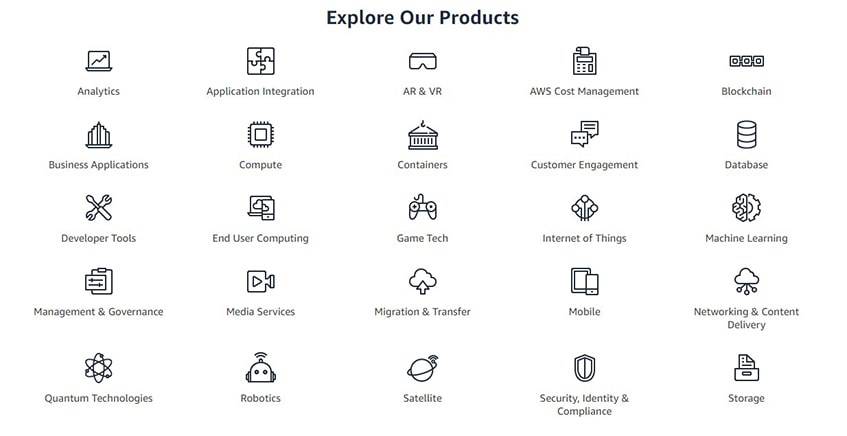
Amazon CloudFront focuses on delivering low-latency content to customers around the world. Hundreds of edge locations and points of presence, as well as several key elements, allow CloudFront to function.
What is Amazon CloudFront All About?
This system is a content delivery network solution that can help serverless applications and websites distribute media more efficiently. It is owned and operated by Amazon, particularly its Web Services suite. The software helps companies send files to clients much faster without overloading their smaller internal systems and software. The program also syncs with other AWS products such as S3 and RDS.
Usage
In simplified terms, Amazon CloudFront serves as a cache for client and company files. More specifically, it’s a distributed cache, meaning it can go to multiple servers. Here’s how it works.
- The network retrieves a file from the origin or source location – for example, a client company’s server.
- It creates copies of the file and stores the new ones in edge locations. There are hotspots in Asia, Australia, Europe, Africa, and the Americas.
- This speeds up the retrieval and downloading process for users who want to access those particular files. It also places less strain on the “origin” (the source company).
Set-Up
As with most CDNs, users must sign up to access it. However, the registration requirements for Amazon CloudFront are quite simple, especially because there is a free tier option. Sign up starts on the AWS website, so make things easier; individuals can search for CloudFront on the homepage.
Once sign-up is complete, users will see an Origin Domain Name box. They can type their domain name there to create an Amazon CloudFront distribution. It will read as [domain name].cloudfront.net.
Network Security
The 2023 system employs several safety protocols to keep customer info safe and secure. When files are flying around to different servers around the world, there is always the risk of interference and ill intent. Fortunately, Amazon CloudFront has protection services in place.
- Web Application Firewall and AWS Shield work to create layered protection against denial-of-service (DDoS) attacks.
- The system automatically creates custom SSL certificates as well as optimizations for greater encryption.
- Users can restrict access to their files through signed URLs and cookies, geo-restrictions, and token authentication.
Encryptions
The platform lets clients send content via SSL or TLS. It turns on security protection automatically while also allowing users to create custom certificates through the AWS Certificate Manager (ACM). This builds an encrypted connection between the customer’s computer or device and the origin server. Alternatively, they could build full or half-bridge HTTPS connections. Other possibilities:
- Field-Level Encryption
- OCSP Stapling
- Perfect Forward Secrecy
- Session Tickets
- TLS Protocol Enforcements
Controls & Accessibility
On top of those encryption settings, users can place accessibility limits of their shared content. Some ways to do this:
- Signed URLs
- Signed cookies
- Token authentication
- Geo-restriction
- Origin Access Identity (OAI)
Security Complianc
All of the processes and systems within this CDN adhere to strict security protocols and are compliant with several security procedures.
- HIPAA
- ISO 9001, ISO 27001, SOC (1, 2, 3)
- PCI-DSS Level 1
Web Application Availability
During periods of high Web traffic, it can be harder for individuals to download and access things like webpages, video-streaming, and online images. To speed up efficiency, the CDN allows users to create a cache of content in the service’s edge locations. These areas are located around the globe, so no matter where a person is, they can have an easier time accessing the files. At the same time, it decreases the strain on the origin server.
Moreover, clients can set up several iterations of their origins to enable redundancy. Amazon CloudFront has a native origin failover function that dips into a secondary origin iteration when the primary one is backed up or unavailable.
Optimization & Asset Libraries
For optimal performance, the CDN keeps track of Internet connectivity and computing to figure out which route requests are more viable. Some of the factors that may impact this include:
- Account performance
- APIs
- Load
- Operational status
- Requests between components
The network analyzes these factors in real-time to find the most efficient transmission routes, both for static and dynamic content. Since lots of websites contain a combination of a mixture of content today (WebForms, comment boxes, login buttons, e-commerce features, etc.), the system also looks at how it can provide flexibility and optimization while caching user behaviors and maintaining network security. It does this through HTTP protocols such as:
- DELETE
- GET
- HEAD
- OPTIONS
- PATCH
- POST
- PUT
One advantage of this is that clients can utilize just one domain name for all of their deliverables on their website. Asset libraries are another benefit because they keep files and objects in the cache for longer periods and, thus, keep speeds high.
Tools For Programmers & Web Developers
The system has various functions that programmers and Web developers can utilize. This includes a full API builder to help organize and maintain network distributions. There are other tools, too:
- AWS CloudFormation: model infrastructure via text files or programming languages
- CodeDeploy: automated software deployments
- CodeCommit: fully-managed source control service
- AWS SDKs: JavaScript, Python, .NET, etc.
Clients can manage their distribution and apply different features accordingly. For instance, they may choose how the network caches files, how it communicates with the origin server, and which metadata goes to the origin. Other possibilities:
- Customize which headers are forwarded to the origin
- Create content variants and cache-key manipulation
- Choose between different compression modes
- Use built-in device detection (desktop, mobile, Smart TV, tablet) and adapt responses accordingly
- Detect locations on the country level and customize responses
Another feature is Lambda Edge, which enables developers to run their code in closer proximity to users. Other perks:
- Respond to requests across global AWS locations
- Deliver compute requests closer to users
- Improved overall user experience
Compatibility
Amazon CloudFront is designed to integrate with all other programs within the AWS suite, including:
- DynamoDB
- EC2
- LightSail
- RDS
- S3
- SES
- SNS
- Other integrations: MSP360, Shopify, Slack, and others
Features
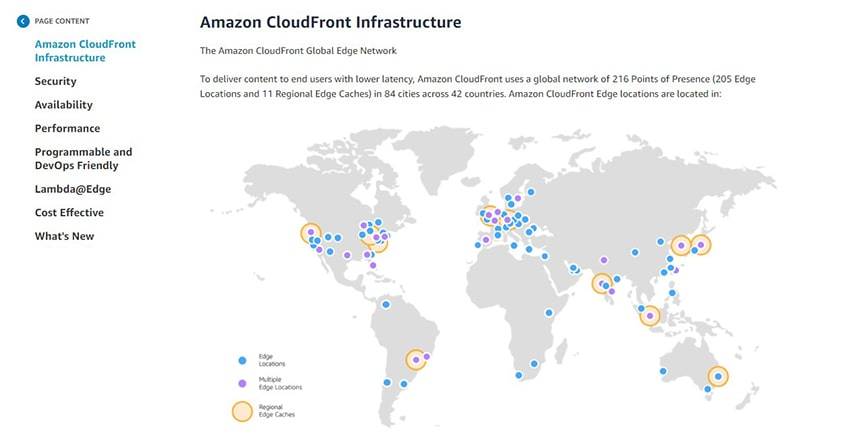
On the whole, this network system works with multiple integrations, both within AWS and among third-party apps. The CDN is designed to integrate with all other programs within the AWS suite.
- DynamoDB
- EC2
- LightSail
- RDS
- S3
- SES
- SNS
- Other integrations: MSP360, Shopify, Slack, and others
Amazon CloudFront Plans & Pricing
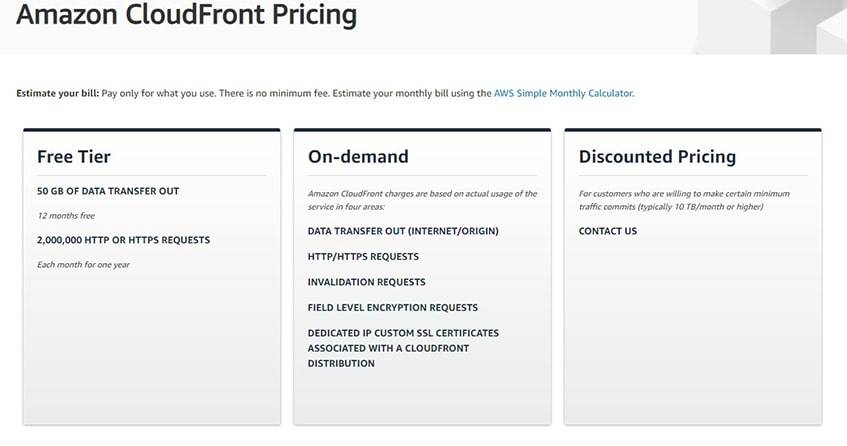
Rather than having a rigid subscription system, the network is offered with a pay-as-you-go model. The easiest way to think of this pricing model is by breaking it up into three primary sections: data exchange out to the Internet, out to origin, and HTTP requests per 10,000. The bulk of the charges come from “regional data transfer out to the Internet,” which refers to how much bandwidth connects the edge servers to the client’s user base.
There is also an unpaid option. Of course, it is more limited in scope, plus it’s only available for one full year before users need to start paying for their usage. The rates below reflect the numbers for North America and Europe. Asia, Australia, and South America have slightly higher rates.
Option #1 Data Transfer Out-to-Internet: Most Expensive (& Efficient)
This plan measures the amount of bandwidth used between the CDN’s edge servers and the customer’s user base throughout the world. The rates below are per gigabyte. It’s more expensive, but it also ensures the greatest efficiency.
PROS:
- May be easier for non-developers to use
- Most streamlined
- Pricing gets lower with more transfer
CONS:
- Most expensive
Option #2 Data Transfer Out-to-Origin: Consistent Pricing, Edge-to-Origin Server
This option entails paying for the information that gets transferred from the network’s edge servers to the user’s origin server. Just as with the first plan, the rates are determined per gigabyte. The difference here is that there is no volume pricing, but a flat rate instead.
PROS:
- DDoS protection
- Less expensive across global locations
- More consistent pricing
CONS:
- Might not be as convenient as out-to-origin plan
Option #3 HTTP Requests per 10,000: Pricing Varies Based on Location
This package charges customers based on the number of HTTP requests in a given period. It looks like the pricing model is per 10,000 requests. Like the other plans, the rates vary depending on the client location (North America and Europe are the cheapest). Costs vary slightly depending on HTTP versus HTTPS.
PROS:
- Cheapest paid package
- Might suit smaller customers best
- Secure tokens
CONS:
- Fluctuating costs
Option #4 Free Tier: Complimentary 50 GB, But Limited Access
This is a good choice for those who want to get a better idea of what Amazon CloudFront is all about. They can try out the unpaid plan and get a complimentary 50 gigabytes of data transfer out, as well as two million HTTP/HTTPS requests per month. This lasts for a year, and then they’ll have to opt for a pay-as-you-go package.
PROS:
- 50 GB of free storage
- Cloud & Web availability
- No cost
CONS:
- Limited accessibility
Pricing & Key Features Comparison Chart
This table will graph out the comparisons and contrasts between the separate plans, making it easier for companies to figure out which is most cost-effective to them.
| Out-to-Internet | Out-to-Origin | HTTP Requests | Free Tier | |
|---|---|---|---|---|
| Starting Price | $0.085 for 1st 10 TB | $0.020+ for all data | $0.0075+ for all requests | $0.00 |
| API | Yes | Yes | Yes | Limited |
| Cache Purge | Yes | Yes | Yes | Limited |
| CNAMEs | Yes | Yes | Yes | Limited |
| Custom SSL | Yes | Yes | Yes | Limited |
| DDoS Protection | Yes | Yes | Yes | Limited |
| Functionality | Cloud/Web | Cloud/Web | Cloud/Web | Cloud/Web |
| GB Storage | 10 TB | 10 TB | 10 TB | 50 GB |
| Gzip | Yes | Yes | Yes | Limited |
| Origin Pull | Yes | Yes | Yes | Limited |
| Raw Logs | Yes | Yes | Yes | Limited |
| Secure Tokens | Yes | Yes | Yes | Limited |
Terms & Conditions
The terms and conditions for this CDN fall under the general terms for Amazon Web Services. These policies are available in Indonesian, German, English, French, Spanish, Italian, Portuguese, Vietnamese, Turkish, Russian, Arabic, Thai, Japanese, Korean, and Chinese. Clients may not transfer any third-party software outside the services without specific authorization. They are responsible for adhering to the license terms of any software they decide to run. The use of some CDN functions may require the utilization of other AWS tools, such as S3.
Privacy Policy
AWS collects certain client details, including registration info, data stored in cookies, and any information that customers give out to third-parties or partner apps. Amazon utilizes these details to improve its services, measure and analyze performance, fix errors, to send out marketing materials, and to communicate with clients. AWS is located in the United States, while its partners are dispersed throughout the globe. As such, customer information may be stored both in the U.S. locations and abroad.
Refund Policy
Certain features within the content delivery network are non-refundable, but a few allow for a pro-rated refund if a request is submitted in writing. If Amazon terminates a user’s account early by accident or due to unforeseen circumstances, they may be eligible for reimbursement.
Customer Support
Below is a review of Amazon CloudFront’s business assistance and client services. These are the different means that people can use to get in touch with brand representatives.
Telephone
For security purposes, AWS (and subsequently, its CDN) doesn’t have a telephone number. That said, current customers can sign in to their accounts and go to the Knowledge Center to create a case. There, they can select the”Phone” contact option and provide their phone number. A service representative will get in touch shortly.
Likewise, the content delivery network does not have a specific support email address. The next best thing is to fill out a request ticket, which individuals can do in the Knowledge Base. This is where they can describe their technical problems and information so a representative can get back to them.
Online Chat
People can go to the “Contact Us” page and then navigate to the online Support Center. There, they will see a list of FAQs. If they select “I need to speak with someone in sales,” they can access the Live Chat option. This feature is available 5:30 a.m. to 4:00 p.m. PST Monday through Friday.
Support Center
Individuals can go to the bottom of the CDN website and select “Knowledge Center.” This will take them to a new page where they can find answers to frequently asked questions as well as additional reviews and resources on all kinds of topics. Some examples include application integration, analytics, and account and billing management. There are also featured videos at the bottom of the page, hosted by AWS employees and experts.
Quality of Service
Overall, tech experts and customer reviews agree that CloudFront is a steady competitor against alternatives. While some of the features require additional AWS tools (such as S3 for origin pull), there is an overwhelming sense of flow. The primary benefits that many reviewers reference include automatic scalability, configuration, and higher deliverability speeds. That said, it can be hard to understand, especially for beginners or those without related background experience.
Customer Types
For those who are wondering who this system is best for, check out some customer types below and how they might consider using Amazon CloudFront.
Small Businesses
A smaller company may or may not want to sign on to this service. It depends on their total Web traffic and where their target audiences are. For instance, a business might experience slow-downs during peak traffic hours, in which case a CDN could be a big help.
Mid-Sized Companies
A medium-sized business is probably more likely to experience higher traffic demands on its website. Therefore, it may want to look into a CDN service provider. Moreover, if it has patrons in different countries, then it wants to do its best to deliver files smoothly and efficiently.
Large Enterprises
A bigger company would want to utilize this kind of system so that it can keep its competitive edge (or build one). To maintain a solid reputation, it must deliver media at a fast rate. A good example is a telecom corporation, which relies on fast speeds to uphold its reputation.
Freelancers
A contractor may want to consider using the unpaid tier option. They can use it for a full year with limited functionality but no payments. It could be worth looking into if they expect big leaps in growth.
Amazon CloudFront Pros & Cons
There are plenty of reasons to look into using CloudFront. It could improve SEO rankings since the site loads faster. The CDN can also be a boon to e-commerce platforms, thanks to third-party integrations and more efficient streaming and content delivery. All that, plus the obvious boost in security.
On the downside, some people may not like the opaque insight reviews and lack of visibility into the back-end structure of the service.
Pros
Cons
- Analytics
- Easy scalability
- Flexible configurations
- Lambda Edge customization
- Security boost
- Opaque network infrastructure
- Pricing variations
Service Alternatives
For those who aren’t sure about using this CDN or want to check out some competitor reviews, take a look at six viable options below.
MaxCDN (StackPath): Additional Traffic Management
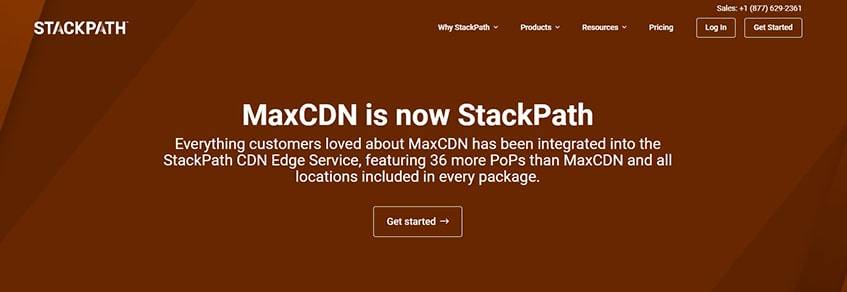
Stackpath (formerly MaxCDN) is based in Dallas, Texas, and offers CDN and WAF services. Some of its primary applications include infrastructure monitoring and DDoS mitigation. Throughout the years, the company has acquired various partners to provide additional safety measures such as cloud security and traffic management.
Akamai Edge: Network Operator Solutions
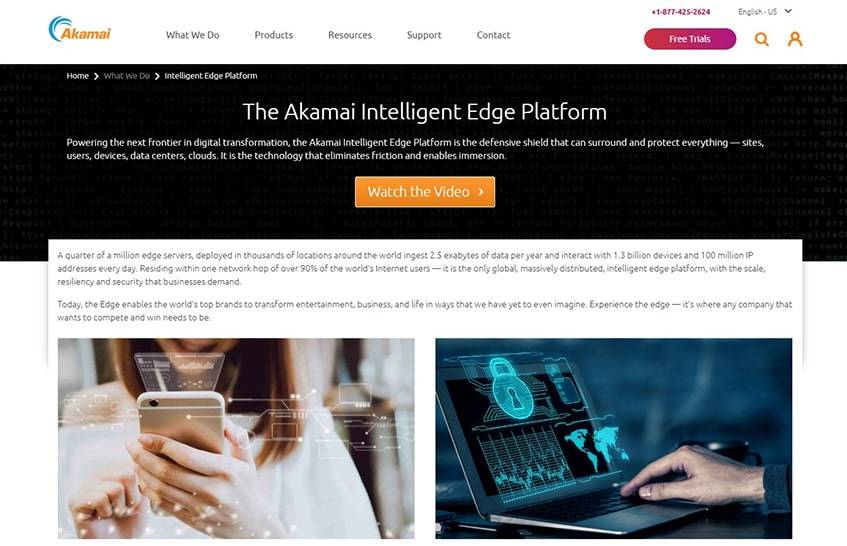
Akamai Edge is an intelligent cloud computing platform that shields users, sites, devices, and data centers from online threats. Its operation solutions protect businesses and their clients while keeping delivery speeds high. Customizable deployment options are available.
Fastly: A Speedy Cloud Platform
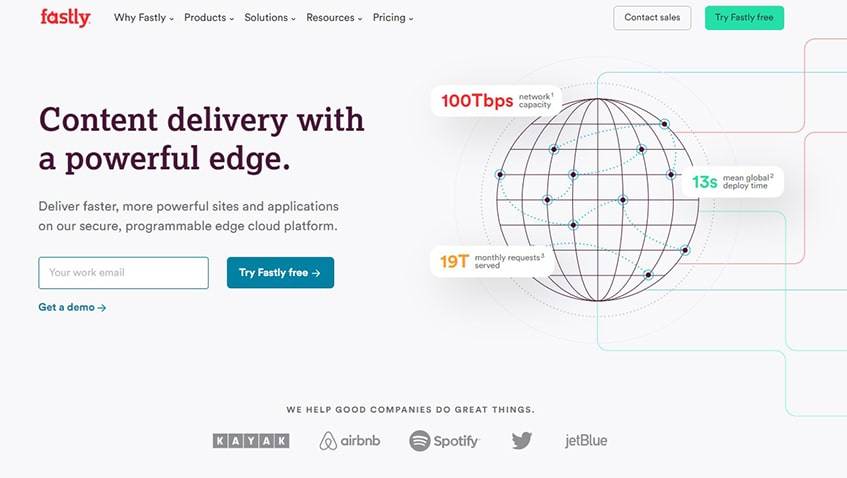
Fastly is headquartered in San Francisco, U.S.A., and offers various Internet security features, including content delivery. Other tools include load balancing, bot mitigation, DDoS attack protection, and streaming services. It offers a pay-as-you-go structure similar to CloudFront.
Incapsula: Customized Deployment

An offshoot of the cybersecurity firm Imperva, Incapsula is a cloud-based application delivery platform that also provides a content delivery network. Its prime features include caching, application sending, failover services, DDoS mitigation, and load balancing.
Azure CDN: Part of a Cloud Services Suite
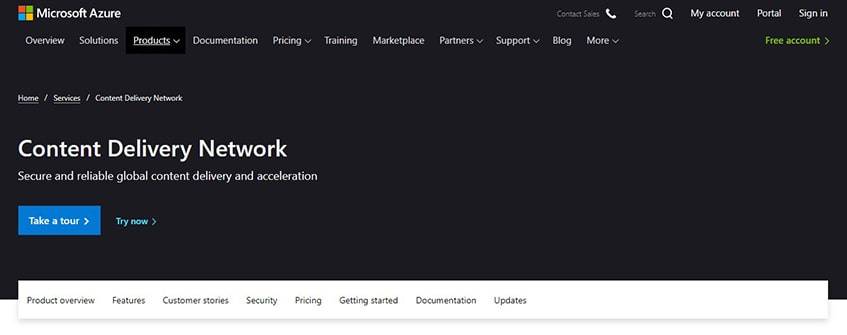
Azure CDN from Microsoft comes with tons of scalability and a convenient pay-as-you-go pricing model. It integrates with Azure’s cloud and media storage services and provides deep insights into customer workflows, engagement, and deliverability.
CloudFlare: A Global Content Delivery Network
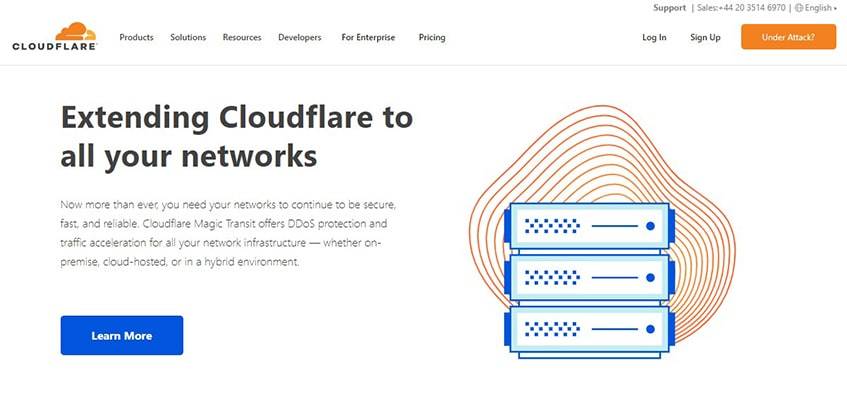
Cloudflare is also headquartered in San Francisco, but it has additional officers in Europe and Asia. As a web security company, it focuses on secure digital infrastructure, DDoS mitigation, and domain-name services. It acts as a bridge between the user’s origin server and their clients’ location.
CloudFront & Alternatives Comparison Table
Check out this side-by-side comparison chart below to see how these alternatives stack up. Remember that the higher-tiered plans may include more functionality and tools. These prices reflect the newest rates.
| CloudFront Service | Stack Path | Akamai Edge | Fastly Service | Incapsula Service | Azure CDN | CloudFlare Service | |
|---|---|---|---|---|---|---|---|
| Price | Pay-as-you-go | $10/mo | Pay-as-you-go | Pay-as-you-go | Pay-as-you-go | Pay-as-you-go | $20/mo |
| Analytics | Yes | Yes | Yes | Yes | Yes | Yes | Yes |
| Anonymous VPN | No | Yes | No | No | No | No | No |
| Caching | Yes | Yes | Yes | Yes | Yes | Yes | Yes |
| Customization | Yes | Yes | Yes | Yes | Yes | Yes | Yes |
| DDoS Protection | Yes | Yes | Yes | Yes | Yes | Yes | Yes |
| Encryption | Yes | Yes | Yes | Yes | Yes | Yes | Yes |
| Free Trial | Yes | Yes | Yes | Yes | Yes | Yes | Yes |
| SSL Certificates | Yes | Yes | Yes | Yes | Yes | Yes | No |
| WAF | Yes | Yes | Yes | Yes | Yes | Yes | Yes |
Frequently Asked Questions
What is the Main Benefit of CloudFront?
The main purpose of this system is to deliver files, media, and other digital information. In this way, it offers a low-cost solution to low-latency deliverables, which helps to improve customer satisfaction and company revenue. Below are the primary benefits of this content delivery system.
- Cost efficiency
- Higher performance
- Integrated networks
- Program customization
- Secured content
Is CloudFront.net Legit?
No. Cloudfront.net is a “virus” that plagues the affected device with pop-ups, unwanted ads, and excessive redirects to different webpages. People who experience this may have clicked on something that gave them the virus. It could also be the result of a hacker.
Is AWS CloudFront Free?
Yes, there is a no-cost option that people can take advantage of for up to one full year. On this plan, they get 50 gigabytes of storage at no cost, but they have limited accessibility to the network’s primary resources. For example, this package won’t come with SSL certificates or full DDoS attack mitigation.
Is CloudFront a Virus?
No, the actual CloudFront website is not a virus. However, there is CloudFront.net, which is an annoying pop-up and redirect feature that results from a virus. It alters the device’s settings and results in unwanted pop-up ads while constantly loading random webpages. It is a suspicious entity and requires anti-malware software to remove it.
How Do I Get Rid of CloudFront Virus?
To remove the CloudFront.net virus from a computer, individuals need to download anti-malware software like CCleaner or Malwarebytes.
- Start by downloading the software.
- Run the program and select the scan option. The software will automatically detect any malware.
- Choose the removal option to get rid of the detected files.
Alternatively, people can manually remove the virus.
- Go to the “Start” menu on the computer
- Navigate to the Control Panel
- Click on “Programs” and uninstall CloudFront and any other unwanted programs
Try For Free & Distribute On Your Terms
This network invites businesses to try it out at no cost and customize their SSL encryptions and data distribution. While the services are available on a pay-as-you-go basis, they are quite reasonable and include lots of functionality and safety. This is also a convenient option for programmers and Web developers, although newbies can get the hang of it, too. If you’ve tried this CDN and want to share your experience, please tell us in the comments below.


Comments